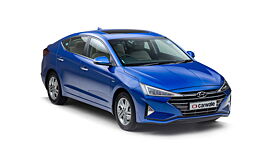What is it?
Why I would buy it?
Feature rich, comfortable and relatively affordable.
Why I would avoid it?
No diesel option.

This is the new Hyundai Elantra and its new in more ways than one. It gets completely new exteriors, plenty of interior updates along with new features and a BS-VI compliant petrol engine. So how good is the new car? Let’s find out. On the outside, Hyundai has made plenty of changes to the Elantra and it’s a much sharper looking car now. There’s a big influx of angular elements like the new grille, headlights and the fog lamps. The bonnet has also been re-sculptured with new creases on it.

On the side, the Elantra remains largely unchanged with its coupe-ish profile retained but it does get new design alloy wheels. At the rear you get new tail lights, again with a very sharp design and the base of the re-profiled bumper gets a black treatment to break the monotony. Overall, the new Elantra’s design comes across as quite busy but it’s still a pleasing design to look at.

How is it on the inside?

Hyundai has a knack of making good looking interiors and the Elantra is no different. The changes include a new steering wheel, new dials for the aircon controls and fresher colours for the interiors. The instrument console also boast a very clean layout and gets a nice carbon fibre finish. The new car now also borrows the Blue Link system from the Venue and enables remote starting the car and fiddle with the aircon controls too. Wireless charging, an eight-speaker music system and tyre pressure monitoring system are some of the additional features. What is also important to note is that the new car gets six airbags standard across all variants.

Getting to the seats, the front seats are pretty comfortable and supportive. They are cooled too and the driver seat gets electric adjustment. Now let’s get to the rear bench.

The sloping roofline at the rear means you do have to squat quite a bit to get to the rear seats and that could be a bit of a trouble for the elderly, but once in, it a good place to be in with plenty of legroom and a comfortable seating posture.
How does it drive?

Compared to its 1.8-litre rivals, the Elantra has always enjoyed a capacity advantage. The new car now gets a BS-VI compliant, two-litre petrol engine and let me add ‘ONLY’ to that because the diesel engine has been discontinued with the Elantra.

With 152 bhp and 192Nm of torque coupled to the six-speed automatic gearbox, the Elantra feels brisk, but the power delivery is so linear that one ends up wishing for a sudden rush of power. But driven in normal conditions, the Elantra feels very refined and offers enough grunt to keep most satisfied. The driving mode further helps to enhance driving depending on the conditions. Fuel efficiency remains identical with Hyundai claiming 14.6 kmpl for this auto variant and the manual.

The Elantra is made to please the family and as a result the ride and handling is pretty comfort oriented. The suspension absorbs bumps well and even with four people in the car we cleared the biggest speed breakers in Navi-Mumbai without breaking a sweat. Sporty handling is not really the Elantra’s forte thanks to a slightly numb steering and body roll creeping in, but like I mentioned before, as a family car the Elantra has it covered.

Should I buy one?

So the new Elantra isn’t as stylish as the Honda Civic, it isn’t as dynamically able as the Skoda Octavia and if you want one in diesel, you just can’t have it. So why would you buy one? Well, with prices starting at Rs. 15.89 lakhs going up to Rs. 20.39 lakhs, the new Elantra is the most affordable car in its segment. It’s also very comfortable, gets plenty of features and the affordable price tag makes it very good value for money and we believe that’s a good enough reason to buy one.

Where does it fit in?

The new Elantra, like before, goes up against the Honda Civic, Skoda Octavia and the Toyota Corolla.
Pictures by - Kapil Angane and Kaustubh Gandhi

































